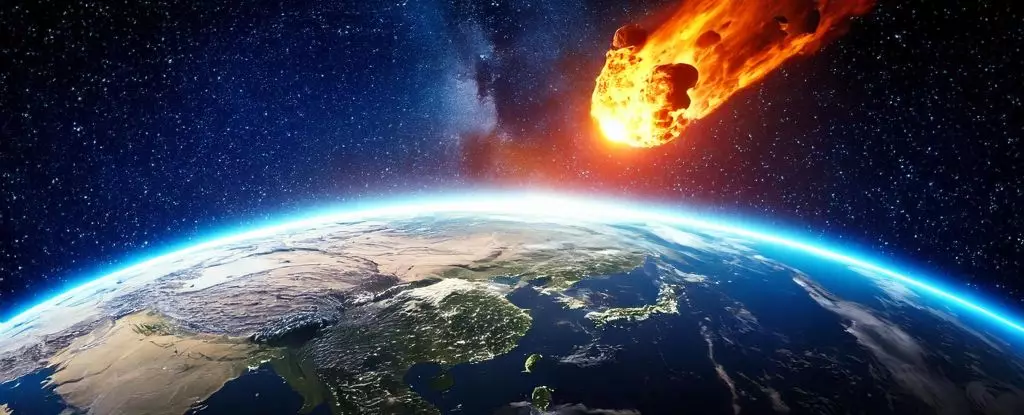As humankind strides bravely into the future, one undeniable truth lurks within the vastness of space: our planet is not safe from cosmic debris. A long span has elapsed since a significant asteroid impact—66 million years, to be precise, since the Chicxulub event catalyzed the extinction of the dinosaurs. Nevertheless, space remains populated with various rocks traveling along unpredictable paths, which could thrust them on a collision course with Earth. A prime candidate for such a fate is the asteroid Bennu, which, although only measuring about 500 meters in diameter, has garnered attention due to its projected trajectory towards our planet. While the odds of an encounter in 2182 CE stand at a mere 0.04%, or roughly one in 2,700, the threat is very much present, urging scientists to explore the implications of a potential catastrophe.
To better comprehend the ramifications of a potential asteroid impact, researchers Lan Dai and Axel Timmerman from Pusan National University harnessed the computational power of the Aleph supercomputer. They modelled a scenario involving a 500-meter asteroid colliding with Earth, investigating the effects rather than focusing solely on the immediate destruction of the impact. Their simulations posited that such an event would eject an astonishing 100 to 400 million metric tons of dust into the atmosphere, yielding disastrous climatic consequences.
The modeled data revealed a projected global temperature decrease of around 4 degrees Celsius coupled with a 15% reduction in precipitation. Furthermore, crucial atmospheric chemistry would face distortion, leading to a staggering 32% depletion of ozone. These shifts imply severe repercussions for global photosynthesis—an essential process underpinning life on Earth. Without sufficient sunlight, both terrestrial and marine ecosystems could face staggering declines in productivity, threatening food security at a foundational level.
One of the most alarming predictions from these simulations is the projected decline in photosynthesis by 20 to 30% in the aftermath of an asteroid impact. This substantial reduction signals potential difficulties in food production, exacerbating the already critical issues surrounding global food security. The future of agriculture could be fundamentally altered, laying the groundwork for widespread famine.
However, amid these grim predictions, a glimmer of hope emerges. While terrestrial plants are noticeably sensitive to environmental shifts and may take years to recover from an impact winter, aquatic life appears more resilient. Researchers noted that marine algae, particularly diatoms, demonstrated the ability to rebound quickly, flourishing within a few months thanks to the influx of nutrient-rich dust introduced by the impact. Remarkably, the iron content from asteroid debris played a crucial role in this unexpected resurgence, suggesting that specific conditions foster adaptive responses in marine ecosystems. This resilience could provide pathways to mitigate food insecurity in a post-impact world.
Though the prospect of colliding with an object like Bennu is sobering, it prompts further inquiry into Earth’s historical interactions with such celestial bodies. Evidence shows that asteroids have impacted our planet more frequently than one might expect. Historically, such events could have even influenced human evolution, given that medium-sized asteroids are believed to strike Earth once every 100,000 to 200,000 years.
Thus, the looming question remains: will humanity endure another cataclysmic event? Experts suggest that while the aftermath of a significant asteroid impact may leave humanity in a precarious position, survival is possible. Global populations may dwindle, but the resourceful nature of humankind—despite facing substantial lifestyle changes—could lead to new forms of adaptation.
Lessons from the Cosmos: The Importance of Preparedness
In light of these revelations, the need for preparedness resonates strongly in discussions surrounding asteroid impacts. Building awareness around the potential consequences of space rock collisions is not merely speculative; it is an urgent call to action. The combined efforts of climate scientists and space agencies could potentially establish robust monitoring systems and disaster response strategies to mitigate the impact of such an event.
As we inhabit a fragile planet in a universe inhabited by unpredictable celestial bodies, recognizing our vulnerability—and our resilience—may ultimately define humankind’s response to the existential challenges posed by future asteroid encounters. The journey does not end with understanding these threats but extends toward proactive preparation, ultimately shaping humanity’s directive among the stars.


Leave a Reply